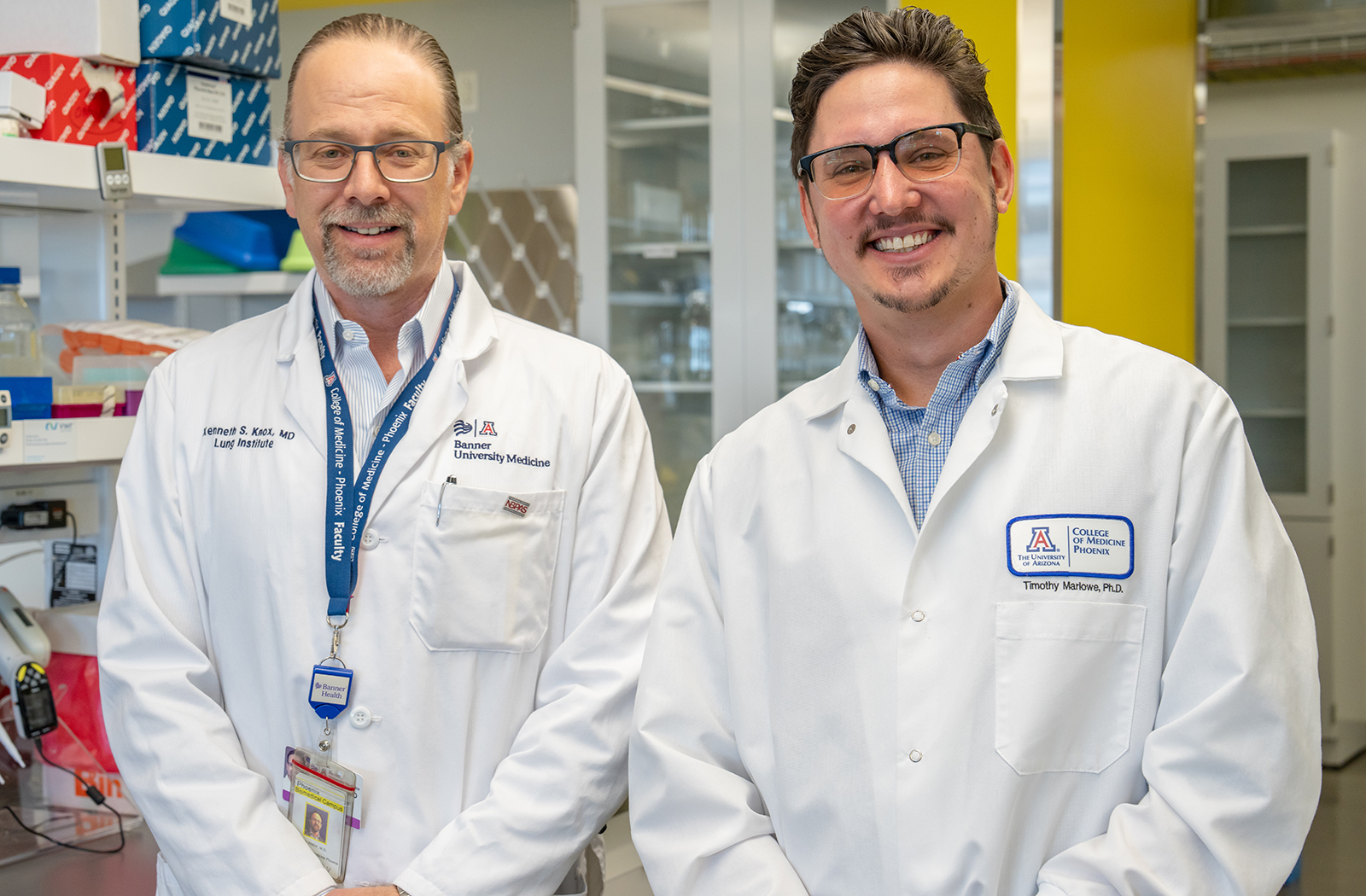
Innovative Therapy Shows Promise in Reversing Lung Scarring in Idiopathic Pulmonary Fibrosis

Idiopathic pulmonary fibrosis (IPF) is a lung disease that progressively scars the lungs, making it harder to breathe. According to the Pulmonary Fibrosis Foundation, more than 250,000 Americans are living with pulmonary fibrosis (PF) and interstitial lung diseases (ILD).
Idiopathic pulmonary fibrosis is one of the most common forms of PF. The prevalence of PF and ILD is on the rise with more than 50,000 new cases diagnosed annually. With limited treatment options and a poor prognosis, patients and clinicians alike are searching for better solutions.
Timothy Marlowe, PhD, assistant professor at the University of Arizona College of Medicine – Phoenix, U of A Cancer Center and College of Pharmacy, and Kenneth Knox, MD, professor and interim division chief of Pulmonary, Critical Care and Sleep Medicine at the U of A College of Medicine – Phoenix, are developing a novel approach that could change the trajectory of IPF and other fibrotic diseases. The project is supported by a grant from the National Heart, Lung and Blood Institute, titled Non-catalytic FAK inhibitors as novel therapeutics for lung fibrosis.
"IPF is a rapidly progressive and highly fatal disease. There are only two FDA-approved drugs available, but they provide only modest benefits and come with severe side effects that often lead many patients to discontinue treatment. More effective and better-tolerated therapies are urgently needed," Dr. Marlowe shared.
Dr. Knox echoed this concern, saying, "Current treatments don't reverse fibrosis; they only slow its progression. Patients often struggle with taking these drugs because they don’t feel any better, and the side effects can be overwhelming. We need a therapy that can not only halt but potentially reverse fibrosis."
Dr. Marlowe’s research focuses on Focal Adhesion Kinase (FAK), a key molecule involved in fibrosis. "What’s exciting about FN-2012 is its ability to break up lung scarring, a function current therapies cannot achieve. Our studies show up to a 90% reduction in lung fibrosis in preclinical models. That’s unprecedented," he explained.
Their team has tested FN-2012 using precision-cut lung slices—tissue from patients who have undergone lung transplants. "When treated with FN-2012, we see a progressive loss of collagen and fibronectin, which are the major components of fibrotic scarring. Unlike other drugs, which still show an increase in scarring over time, FN-2012 is actively reducing it," Dr. Marlowe added.
Dr. Knox highlighted the broader implications of this research. "If this therapy works, it could be applied to other lung fibrosis conditions and even fibrotic diseases in other organs. It could be a game-changer."
The team’s Phase I research demonstrated FN-2012’s effectiveness. "The results were remarkable, showing significant reductions in fibrosis across multiple models," Dr. Knox noted.
Now, the project is advancing into Phase II with a focus on manufacturing and regulatory approval. "Our main goal is to prepare for an Investigational New Drug (IND) application, which is required before we can begin human clinical trials. We are conducting rigorous safety and toxicity studies to ensure FN-2012 meets all FDA requirements." Dr. Marlowe said.
Advancing FN-2012 to clinical trials presents challenges, including large-scale manufacturing and regulatory hurdles. "We’ve partnered with top-tier regulatory consultants and manufacturing labs to ensure we meet the necessary standards," Dr. Marlowe explained. Dr. Knox emphasized the importance of a well-designed clinical trial. "IPF is a rare disease, which makes trial design critical. We need to determine whether FN-2012 should be studied as a standalone treatment or in combination with existing therapies. Getting this right is essential for a successful trial."
Beyond IPF, FN-2012 may have applications in liver, kidney and pancreatic fibrosis. "Fibrosis is a common thread in many diseases," Dr. Marlowe said. "If we can target it effectively, we could see a ripple effect across multiple conditions."
Dr. Knox added, "The potential impact is enormous. If we can provide a treatment that not only slows fibrosis but reverses it, we could change the trajectory of this disease and many others."
With FN-2012 advancing toward clinical trials, researchers remain committed to bringing this therapy to patients, offering renewed hope for those affected by IPF and other fibrotic conditions.
If you are looking for ways to contribute to the science of curing scars, please contact Julie Bowe.
Research reported in this story was supported by the National Heart, Lung, and Blood Institute under project number R42 HL162392.
The content is solely the responsibility of the authors and does not necessarily represent the official views of the National Heart, Lung, and Blood Institute.
About the College
Founded in 2007, the University of Arizona College of Medicine – Phoenix inspires and trains exemplary physicians, scientists and leaders to advance its core missions in education, research, clinical care and service to communities across Arizona. The college’s strength lies in our collaborations and partnerships with clinical affiliates, community organizations and industry sponsors. With our primary affiliate, Banner Health, we are recognized as the premier academic medical center in Phoenix. As an anchor institution of the Phoenix Bioscience Core, the college is home to signature research programs in neurosciences, cardiopulmonary diseases, immunology, informatics and metabolism. These focus areas uniquely position us to drive biomedical research and bolster economic development in the region.
As an urban institution with strong roots in rural and tribal health, the college has graduated more than 1,000 physicians and matriculates 130 students each year. Greater than 60% of matriculating students are from Arizona and many continue training at our GME sponsored residency programs, ultimately pursuing local academic and community-based opportunities. While our traditional four-year program continues to thrive, we will launch our recently approved accelerated three-year medical student curriculum with exclusive focus on primary care. This program is designed to further enhance workforce retention needs across Arizona.
The college has embarked on our strategic plan for 2025 to 2030. Learn more.